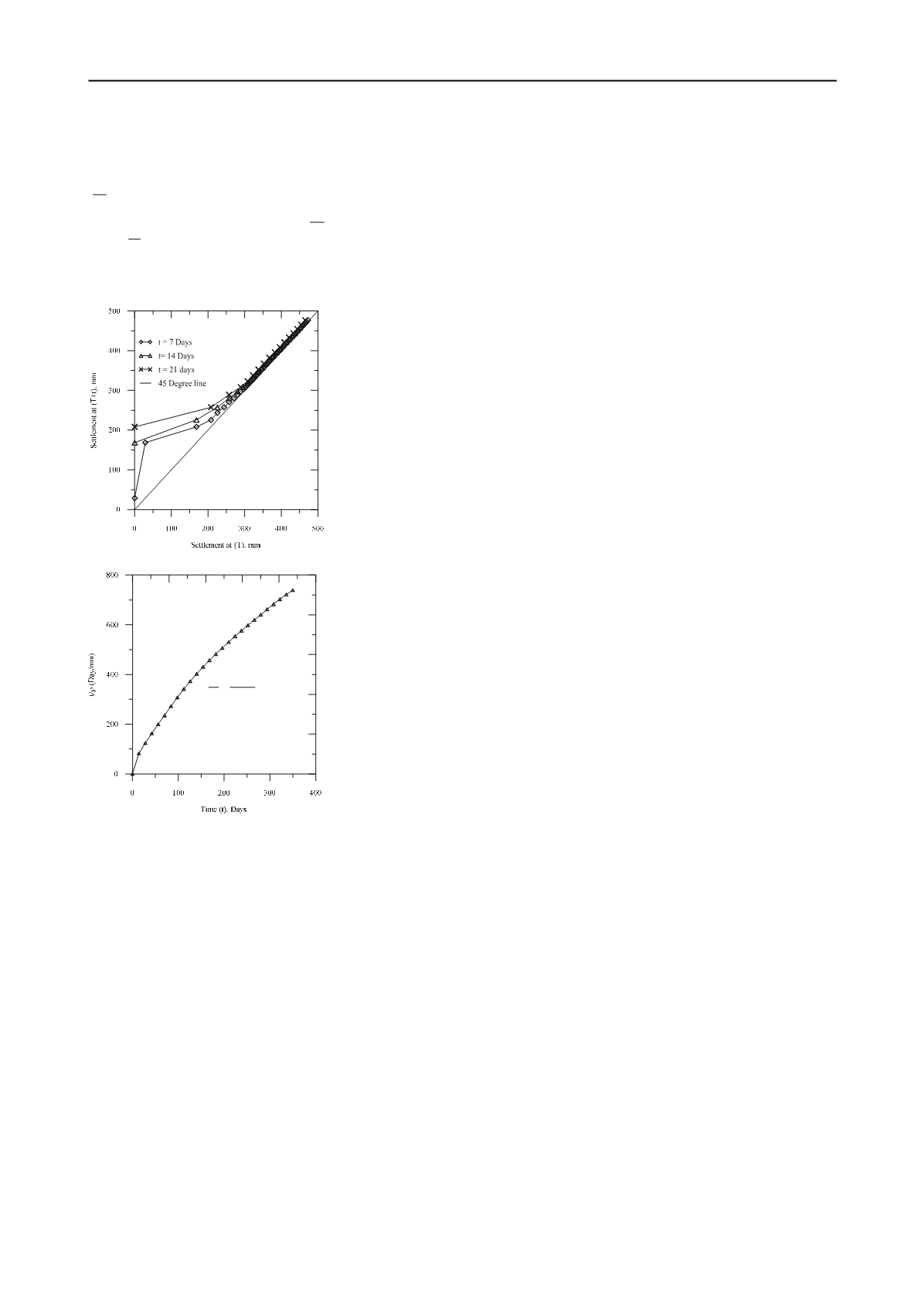
1294
Proceedings of the 18
th
International Conference on Soil Mechanics and Geotechnical Engineering, Paris 2013
In the Hyperbolic method, the relationship between
settlement (
t
) at any time (
t
) is given by Eqn. 3 and the
ultimate settlement by Eqn. 4.
t
t
mt
(3)
This is a linear straight line in a plot of
t
t
against
t
.
1
ult
m
(4)
where
, ,
m
are the co-efficients representing the
theoretical slope factor, intercept and slope of the straight line
respectively
Figure 6. Observational approaches for predicting settlement: (a)
Asaoka; and (b) Hyperbolic
In the NBR embankment field study, the ultimate settlement
predicted using the Asaoka and Hyperbolic methods were
almost identical (517.00 mm and 517.25 mm respectively). On
the other hand, it was observed that the measured field
settlement at 360 days was about 480 mm, whereas the
predicted settlements obtained from the MCC and EVP analyses
at 360 days were 425.55 mm and 498.00 mm respectively.
5 CONCLUDING REMARKS
The long-term performance of the instrumented preloaded NBR
embankment founded on a soft sensitive estuarine clay was
numerically modelled using the MCC and creep-based EVP
models. It was observed from the field monitoring data through
a settlement plate and piezometer that creep-based settlement
was ongoing and, after 360 days, ultimate settlement was not
attained. Although the MCC model ignored creep, which
resulted in it under-predicting ultimate settlement. Measured
settlement was well captured by the creep-based EVP model.
On the other hand, the MCC model captured the excess pore
water pressure prediction better than the creep-based EVP
model, particularly up to 73 days. As there may have been rain
after 73 days, which would have raised the ground water level,
further study is being undertaken to ascertain the excess pore
water pressure. To predict ultimate settlement through an
observational approach, two methods were used: the Asaoka
and Hyperbolic, with their predictions compared with those
from FEA-based MCC and EVP analyses. It was observed that
the modified calculation of the Asaoka method predicted almost
identical magnitudes of ultimate settlement as the Hyperbolic
method and FEAs.
6 ACKNOWLEDGEMENTS
The first author was supported by the Tuition Fee Scholarship
(TFS) while conducting his Doctoral research at UNSW
Canberra. The support provided by the National Computational
Infrastructure (NCI) facility, Australia and QDTMR, Australia
are gratefully acknowledged.
7 REFERENCES
Arulrajah A. 2005. Field measurements and back-analysis of Marine
clay geotechnical characteristics under reclamation fills.
Doctoral
Thesis,
Department of Civil Engineering, Curtin University of
Technology, Australia.
Asaoka A. 1978. Observational procedure of settlement predictions.
Soils and Foundations
18(4), 87-101.
Bergado D., Asakami H., Alfaro, M.C. and Balasubramaniam A.S.
1991. Smear effects of vertical drains on soft Bangkok clay.
Journal of Geotechnical Engineering, ASCE,
117(10), 1509-1530.
Carter J.P. and Ballam N.P.
1995. AFENA User’s Manual. Version5.0
[computer program].
Center for Geotechnical Research
, University
of Sydney, Sydney-2006, Australia.
Geologismiki Geotechnical Software, CPeT-IT v 1.7,CPT interpretation
software,
(2012),
-
IT.html
Islam, M. N., Gnanendran C. T., Sivakumar S. T. 2012. Effectiveness of
Preloading on the Time Dependent Settlement Behaviour of an
Embankment.
GeoCongress 2012, ASCE,
2253-2262.
Islam, M. N., Gnanendran C. T., Sivakumar S. T. 2013. Time dependent
settlement behaviour of embankment on soft sensitive clay. 18th
South Asian Geotechnical & Inaugural AGSSEA Conference,
Singapore (Submitted and under review).
Karim M. R.,Gnanendran C. T.,Lo S. C. R., Mak J. 2010. Predicting
the long-term performance of a wide embankment on soft soil using
an elastic
–
viscoplastic model.
Canadian Geotechnical Journal
47(2), 244-257.
Länsivaara T. 2003. Observational approach for settlement predictions.
Deformation Characteristics of Geomaterials / Comportement Des
Sols Et Des Roches Tendres
, Taylor & Francis, 1277-1285.
Main Roads 1991. Gooding’s Corner G
eotechnical Investigation.
Main
Roads of Queensland, Materials and Geotechnical Services
,
Report: R1748, Australia.
Main Roads 1999. Additional Geotechnical Investigation, Nerang-
Broadbeach Road, Gooding’s Corner
.
Main Roads of Queensland,
Transport Technology, Geotechnical and Geological Services
,
Report: R3161, Australia.
Main Roads 2000. Preload Monitoring: Nerang- Broadbeach road,
Goodings corner deviation and Neilsens road intersection.
Main
Roads of Queensland, Transport Technology, Geotechnical and
Geological Services
, Report: MR1822, Australia.
Main Roads 2001. Additional Geotechnical Investigation for the
Proposed Western RSS Wall Area, Nerang-Broadbeach Deviation,
Gooding’s Corner.
Main Roads of Queensland
, Report: R3233,
Australia.
Roscoe K. H. and J. B. Burland 1968.
On the generalized stress-strain
behavior of wet clay
. Cambridge University Press, Cambridge, UK,
535-609.
Tan S.A. 1995. Validation of hyperbolic method for settlements in
clays with vertical drains.
Soils and Foundations
35(1), 101-113.
Tan S.A. and Chew S.H. 1996. Comparison of the Hyperbolic and
Asaoka observational method of monitoring consolidation with
vertical drains.
Soils and Foundations
36(3), 31-42.
Teh C.I. and Houlsby G.T., “An Analytical Study of the Cone
Penetration Test in Clay”, Geotechnique, 41(1), (1991), pp. 17
-34.
(a)
(b)
t
ult
R
2
Days mm
7
519.00 0.991
14
517.50 0.996
21
517.00 0.992
2
0.9026
1 1000
1.745
0.994
517.25
ult
m
R
mm


